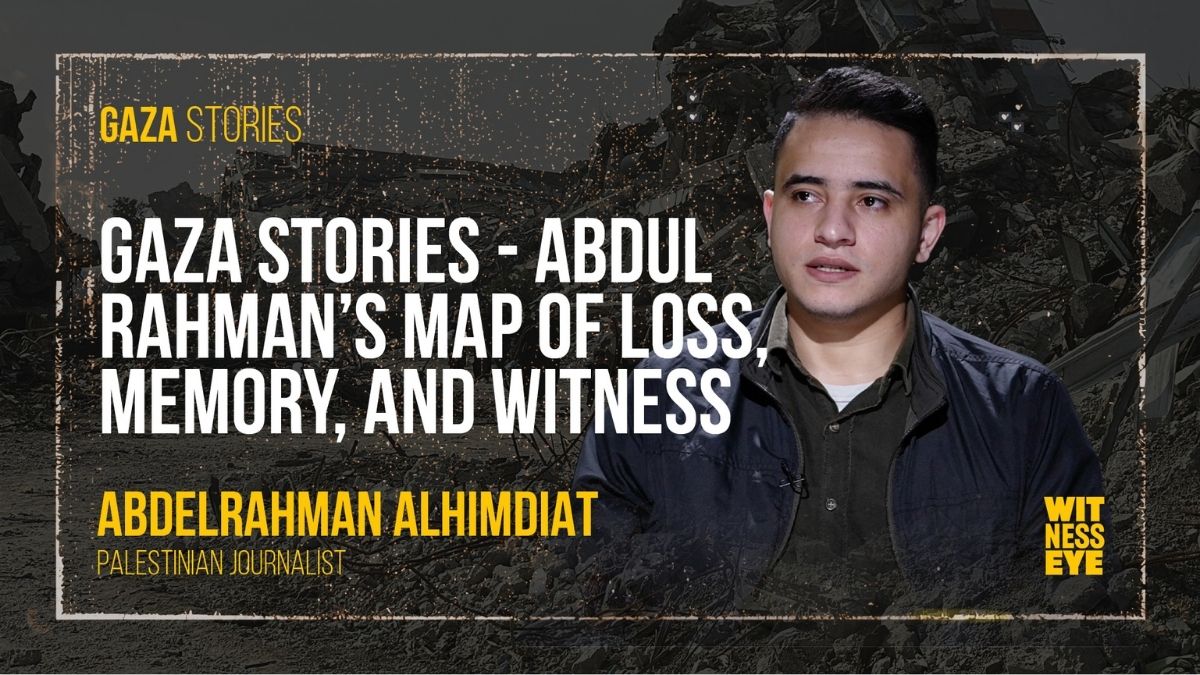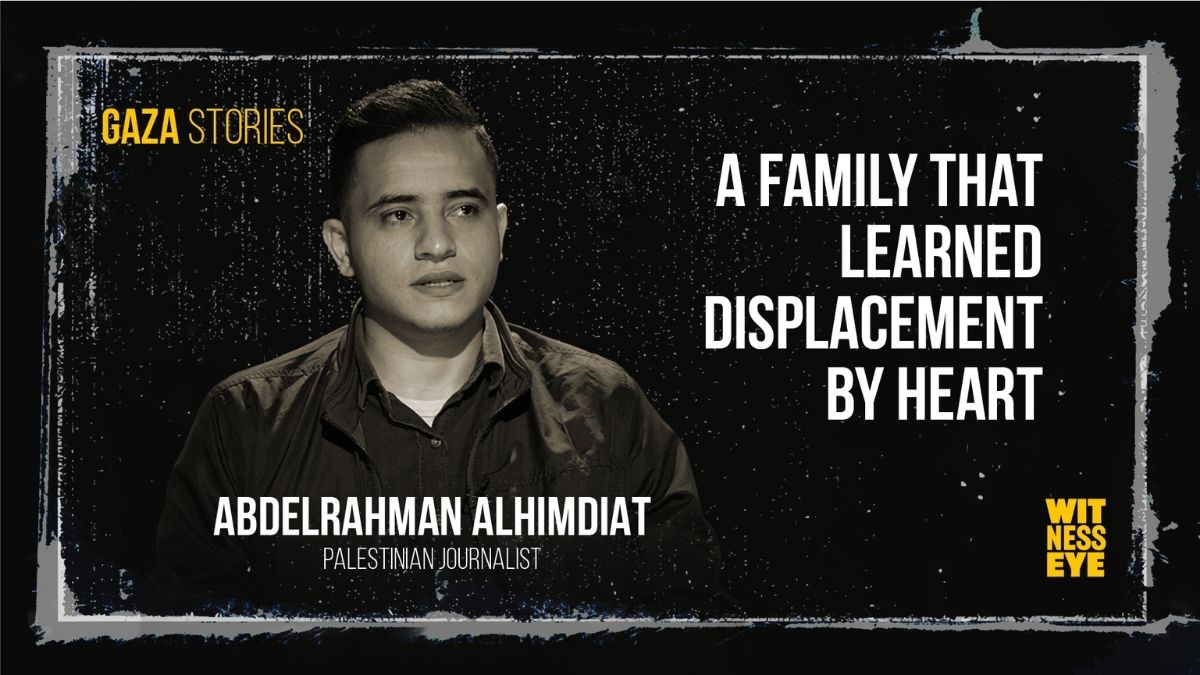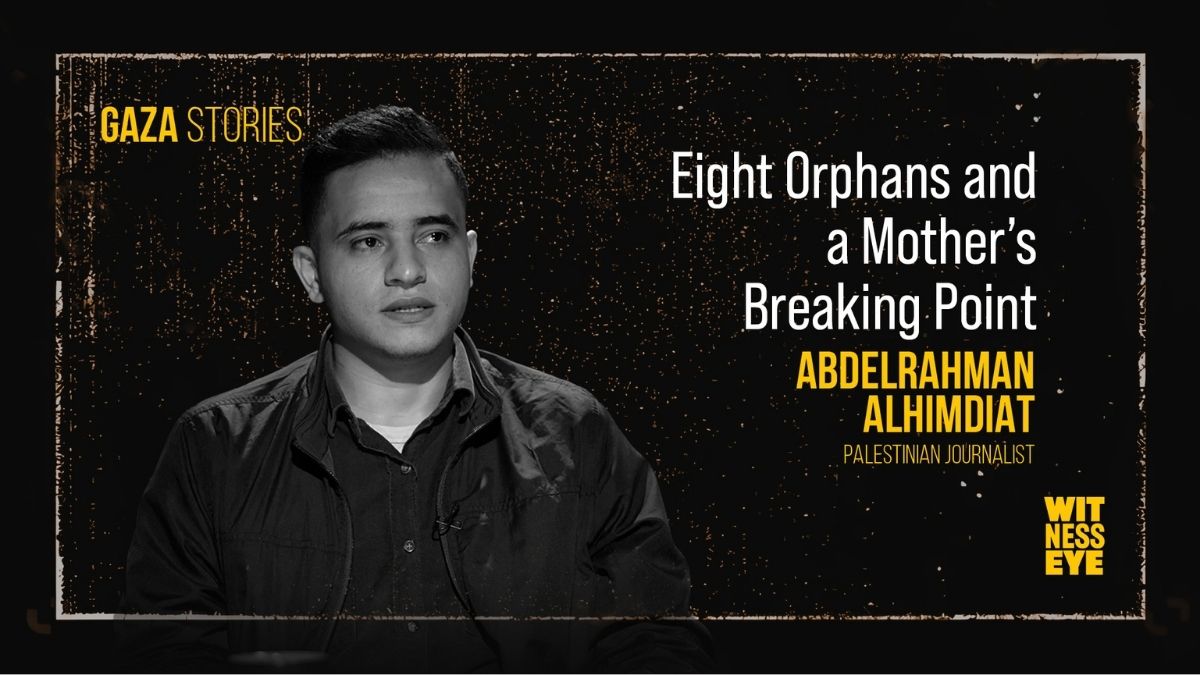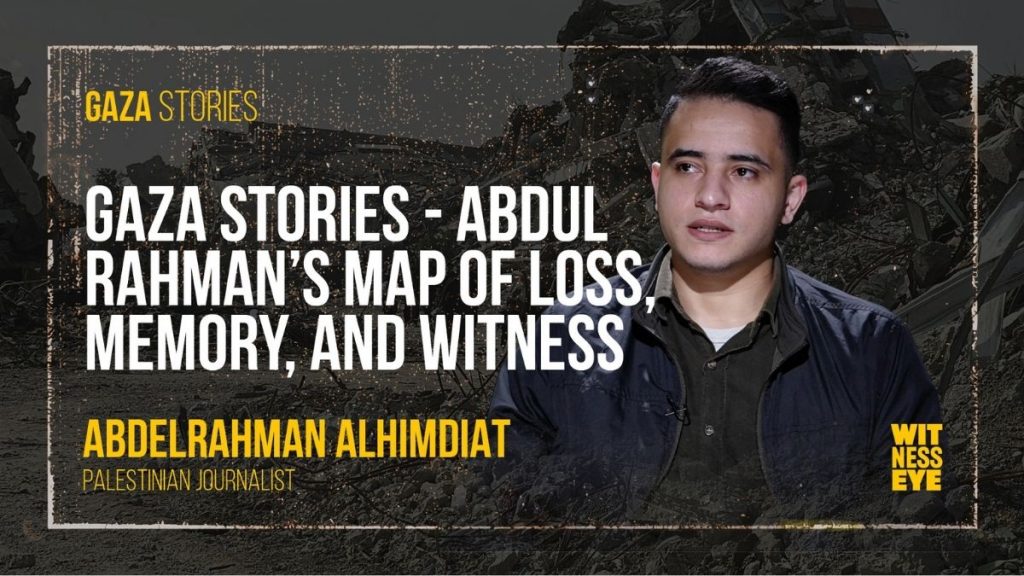
The first thing you hear is a name said softly: Abdul Rahman Al-Hamdiyat. He sits far from Gaza, a master’s student in new media, eyes held by live feeds that don’t blink. He watches the war and waits for messages to land through broken networks. He counts the hours his father spends alone in the north, a cancer patient surrounded by silence. He tracks the last calls from a sister who stands on a balcony for one bar of signal. He remembers the street corner in Jabalia by a desalination station—the landmark where the screen, the neighborhood, and his life fold into the same frame. This isn’t a distant tragedy to summarize. This is Gaza Stories, told by a son who could only witness.
“The feeling of helplessness is deadly,” he says. “You hear your father’s groans and can’t do anything.” The sentence lands with a dull weight, like a brick from a collapsed wall—one you can pick up, but never put back where it belongs.

A Family That Learned Displacement by Heart
Abdul Rahman’s roots trace to Al-Majdal (Ashkelon). His family fled in 1950 and never returned. “We remained refugees all our lives. Wherever we go, we are refugees.” Seven daughters, three sons—an extended household that represents Gaza’s living archive. Daughters married, sons studied, everyone learning, teaching, pushing toward a future that kept moving the goalposts.
The future looked ordinary, even hopeful. Then October 7 arrived and reordered every map. The family home in Sheikh Radwan sat at the edge of an evacuation zone, “in the heart of the last evacuation area,” he says, near Jabalia. Bombardment turned movement into risk. His father stayed behind, too sick to move; siege turned his diagnosis into a sentence. Al-Shifa—once treatment, then military barracks—stood close yet unreachable. Food didn’t arrive. Water didn’t arrive. Safety never arrived.
Half the family drifted south under force. “There was no safety anywhere,” he says. The rest in the north faced deliberate starvation. And through it all, the family WhatsApp group became an emergency room for words. If you want to understand Stories of Survival—the tag that sits on so many testimonies—start here: a family learns to breathe in text bubbles while the electricity blinks out.
See other families navigating the same cliff edge in Gaza’s Missing: Thousands Lost in the Shadow of War and Gaza justice: Voices of Justice and Grief from Gaza. These pieces live in our Gaza Storiesarchive and carry the same heartbeat.
“Please Don’t Forget My Mother”: A Sister’s Last Day
His sister lived with her husband’s family in Jabalia—people who “had no connection to weapons,” he insists. When the army encircled parts of the camp, she fled to another corner of the north, then returned when troops withdrew. That morning, Abdul Rahman did what he had done every morning for months: he watched the news. He saw footage from a strike beside the desalination station. He recognized the street before anyone named the family.
He tried to talk himself out of recognition. He sent screenshots to the family group and typed the sentence you send when you’re trying to keep someone from drowning: Maybe it’s not them. But the video kept rolling. He recognized the children. He also knew he shouldn’t say it yet. “This truth needs to be broken down,” he says, “you want to prepare them.”
“My sister’s husband and children came out alive from under the rubble,” he says. “My sister’s son was crying—‘Please don’t forget my mother.’”
The building had four floors. Three collapsed. The ground floor survived, where her husband and the children crouched. She stood on the balcony, chasing a signal to reach her father. Minutes later, they “found my sister in the middle of the street,” thrown by the blast. The day left behind three orphans and a wound that doesn’t close.
We document these losses because War Crimes Documentation isn’t a slogan; it’s a ledger of names. We link them to the Civilian Impact Reports and Civilian Casualty Mapping that turn grief into data points, and then we push those points toward International Humanitarian Law where duty lives on paper. Gaza Stories returns again and again to this crossing: the street where a person dies and the page where their life must be recorded.

Eight Orphans and a Mother’s Breaking Point
Loss didn’t stop with one sister. Another sister’s husband, Saed Al-Ghafir, died while delivering relief. He and his team reached Al-Wafa Hospital in Al-Shuja’iyya during a so-called calm. “They bombed the hospital directly,” Abdul Rahman says. His brother-in-law had four daughters and a son named Yassin, born after a decade of waiting. “My life and my hardship are for this boy,” Saed used to say. The boy now carries a name that will always mean almost had enough time.
Count the children: three without a mother, five without a father. Count the adults trying to anchor them: one grandmother who holds her tears back on calls so her children abroad can keep working, keep sending what they can. Except for weeks, even months, no cash moves. Banks don’t function. Cards don’t swipe. “The money that burned, melted, was buried, or stolen,” Abdul Rahman says. He talks about Maslow’s hierarchy as if someone flipped it upside down; survival sits at the top like a broken lightbulb, flickering when aid trucks briefly pass.
He doesn’t ask what they ate that day. He wants to help without hearing the part that collapses a person.
“Imagine my mother tells me they found a frog or turtle and ate it,” he says. “What would my reaction be?”
He chooses fewer questions, more transfers—whenever liquidity exists. That’s not detachment. That’s a son shaping his pain into something that moves.
When we place this testimony beside other Witness Eye work—Gaza Stories: A Mother’s Last Words, A Family’s Goodbye, Gaza Stories: Hossam’s Fight to Witness, Final Words: Between Grief and Duty—you see a pattern emerge. Gaza Stories doesn’t repeat itself because people repeat themselves. Gaza Stories repeats because the violence repeats.
A Journalist, A Son, and the Duty to Speak
Abdul Rahman studies digital media and writes about Palestinian history. He also documents a present that keeps dragging the past forward. “I’ve lived through three wars—2008, 2012, 2014,” he says. The list continues: escalations until he left Gaza in 2021, then the war that won’t end. Living in Turkey gives him one fragile thing—space to speak without fear. He meets friends, explains the unexplainable, and still senses a gap. “No matter how much you explain, the idea won’t reach them,” he says. That’s why the camera stays on, even when the heart wants to turn away.
He describes a dissociation that many young people share now: your phone shows blood and broken concrete for hours; then you step outside to buy bread. The heart splits to survive the jump. “We don’t resemble the world,” he says. “We try to deal with it, but there’s a dissociation.” This is where Eyewitness Testimonies do their hard work: they bridge the distance between a screen and a person.
History Doesn’t Sleep: From 1948 to the Present Hour
Abdul Rahman handles history like an engine. He lifts the hood and shows how it runs. The Nakba didn’t finish in 1948; it changed shape. “The war of extermination in 1948 is currently the 2024 war,” he says. “The 2023 and 2025 war is a developed version… with the same method and same Zionist mentality.” He points to earlier massacres, to market bombings in Haifa and Jaffa during the British Mandate, to the King David Hotel attack, to the iron logic of forced displacement. If we zoom out just a little, we see the loop: starvation, siege, expulsion, return barred, records erased, maps redrawn—and then the tents.
He knows people will argue, “But October 7 started this one.” He responds by pushing the timeline backward through centuries of policy and persuasion, through colonial planting and Congresses, through propaganda that called Palestine “a land without people.”
That’s why International Justice can’t just speak in generalities. It has to meet names, homes, dates, deeds—Digital Evidence Archive entries, Forensic Investigations, Social Media Evidence curated before algorithms bury it. It has to listen to Gaza Tribunal Reports, map Destruction of Civilian Infrastructure, and fold cases into Legal Accountability. Like we touched on earlier, Gaza Stories sits at the hinge where pain becomes proof.
For more context on public testimony work, read Gaza Tribunal’s First Public Session in Bosnia and browse Bosnia public session in our archive.

What Accountability Looks Like When the Cameras Leave
Ask Abdul Rahman whether international justice still means anything. He pauses. “This is the most difficult question,” he says. He sees double standards play out in real time. He watched AI-generated images circulate in the first days after October 7 while major outlets echoed official lines. He listened as a defense minister called Palestinians “human animals.” Then he counted 214 journalists killed to stop a different narrative from breathing.
So let’s layer one more truth on top: accountability can’t survive as an abstract noun. It needs infrastructure—an Accountability Watchlist that tracks units and officials; Military Conduct Analysis that tests claims against targeting patterns; Crimes Against Humanity files that align Genocide Evidence Files with Gaza Tribunal evidence; Gaza legal review that names violations of International Humanitarian Law; and casework that moves through courts, not just timelines.
Our newsroom keeps these strands together—War Crimes Documentation and Civilian Impact Reports beside Witness Eye essays, and Gaza Tribunal materials side by side with Gaza justice features. We also keep Gaza Stories as a living series because stories persuade the conscience to move where statutes alone hesitate.
Related reads from the same series: A Test for Humanity — Part 1 and When Law Collapses — Part 2. You’ll find them filed under Gaza Stories (category) and Gaza Tribunal (category), with additional updates in News.
The Weight of Names, The Work of Memory
Numbers tell one kind of truth; names tell another. Abdul Rahman names his father—seventy, ill, ferried south by the Red Cross after three months of siege. He names his sister, thrown into the street by a blast she couldn’t evade. He names his brother-in-law, the relief worker who fed people until a hospital roof fell. He names the nephew who whispers, Don’t forget my mother. That sentence stays. It becomes the spine of Gaza Stories, and also its promise.
“Our feeling is different, our dealing with the world is different,” he says. Maybe that’s the hardest line to read if your life isn’t punctuated by sirens. But it’s also an invitation. We can close the gap. We gather Digital Evidence Archiveentries; we cross-reference Social Media Evidence with Forensic Investigations; we keep Gaza war crimesfiles updated even when the headlines drift. Each act of naming pulls another life back from the blur.
He also names the lie that keeps surfacing: the tents are safe. “Tons of missiles fall on fabric,” he says, describing strikes in Mawasi Khan Yunis and Mawasi Rafah. The footage showed bodies vaporized. He still asks, “What’s the goal?” It’s a question International Justice must answer in court language: intent, pattern, command responsibility. It’s also a question Gaza Stories keeps asking with human words: Who was here? What did they dream of? Who do we call now to tell them their person is gone?
That’s why we keep the work stitched together across our site. Gaza Stories holds the voices. Gaza War and Gaza War Crimes keep the chronology. Gaza Tribunal Reports and Gaza Tribunal evidence move the files along. Accountability Watchlist and Legal Accountability Cases make sure names don’t slip through the cracks. Witness-Eye-Besa and Besa Witness Eye trace partnerships built for this exact hour. And when a policymaker shrugs, we route them through Crimes Against Humanity and International Humanitarian Law, then ask them to read Gaza Stories out loud.

What Stays
So where does that leave us? Abdul Rahman ends where he began: with duty. “Every Palestinian has dozens of wars inside him,” he says. The outside war might pause; the inner ones continue—home gone, friends missing, future unclear. Even then, he keeps his voice steady, because someone has to carry the story forward to the next hearing, the next classroom, the next kitchen where a grandmother dials from a dark room and pretends she’s strong.
Gaza Stories doesn’t promise closure. It offers something sterner: witness that doesn’t look away. It gathers Gaza testimonies and aligns them with human rights violations Gaza records. It keeps files open under Gaza genocide, adds context from Military Conduct Analysis, and situates every name inside international justiceframeworks. And when someone asks whether justice will come at all, the answer sounds like a promise made to a child at a graveside: we will not forget.
If you need a place to start, walk through our Gaza Stories category, then move to the Gaza Tribunal category, and check News for updates on hearings, filings, and Gaza legal review briefs. Gaza Stories lives there—in the overlap between a headline and a kitchen, a live feed and a street where a father once stood, looking for his daughter.
Now, hear the testimony of Abdul Rahman Al-Hamdiyat in his own words—digital media researcher, expatriate, survivor—carrying Gaza’s grief, memory, and unyielding call for justice into the record of history.
Published By Besa Witness Eye
Stay Connected with Witness Eye
Follow us on our official channels:
